6 Best AI Marketing Analytics Tools in 2025
Looking for the best AI marketing analytics tool to quickly grasp the performance of all your marketing channels?
Let’s make sure you pick the best one for your needs.
To make your search easier, we highlight key differences between the 6 best AI marketing analytics tools marketers are raving about in 2025.

Feb 06 2025●10 min read
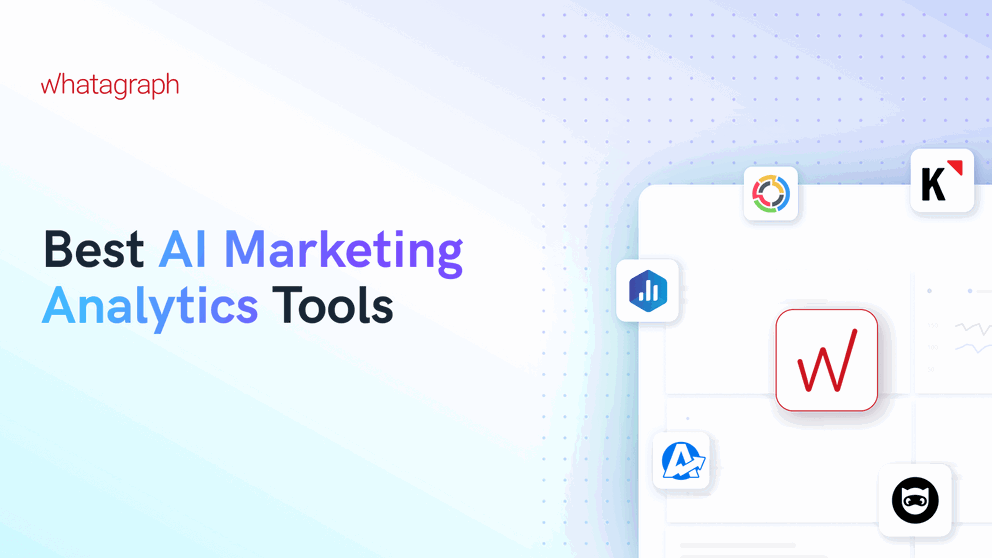
We talked to marketing experts from agencies and big in-house teams. They told us what they’re looking for in an AI marketing analytics tool:
✅ Reliable integrations: Bring all your data from all your channels into one space.
✅ Clean data: Consolidate and prepare data for AI analysis.
✅ Actionable AI insights: Share clear, actionable recommendations, not basic observations.
✅ Performance monitoring: Get a clear view of performance, both for your clients and your internal team.
✅ Security: Comply with data privacy regulations.
6 Best AI Marketing Analytics Tools in 2025
Here are the best AI marketing analytics tools we’ll review in this article:
- Whatagraph
- AgencyAnalytics
- Klipfolio
- Databox
- NinjaCat
- TapClicks
Already using AI marketing analytics software and want to compare how it stands against the competitors’ features? Here's a table:
| Features |
|

|

|

|

|

|
|---|---|---|---|---|---|---|
| Ease of use | EasyEasy | Easy | Hard | Medium | Medium | Easy |
| No. of Out-of-the-box Data Connectors | 55+ | 80+ | 130+ | 100+ | 150+ | 200+ |
| Custom API Access |
|
|
|
|
|
|
| Data Blending |
|
|
|
|
|
|
| Custom Metrics and Dimensions |
|
|
|
|
|
|
| Custom Reports and Dashboards |
|
|
|
|
|
|
| Campaign Overview and Monitoring |
|
|
|
|
|
|
| White-labeling |
|
|
|
|
|
|
| Data Update Frequency | Every 30 mins across all integrations and pricing plans | Depends on APIs, but SEO rankings update every 24 hours | Depends on your pricing plan, from 4 hours to 30 minutes | Depends on APIs and your pricing plan, from 1 to 24 hours | Every day or manual data refresh | Automatically everyday or manual refresh |
| Data Segmentation and Filtering |
|
|
|
|
|
|
| Alerts and Notifications |
|
|
|
|
|
|
| Multi-Client Management |
|
|
|
|
|
|
| User Management | Admin, Manager, or Editor roles | Staff User or Client User | Account Administrator, Klip Viewer, Klip Editor | Administrator, Editor, User, or Viewer roles | System Admin, Standard User, Restricted Partner, Dashboard User, Account Executive, and more | Super admin, Business unit admin, Agent, Client |
| Automated Report Sharing |
|
|
|
|
|
|
| Data Export | PDF, XLS, CSV | PDF, CSV | Export dashboards as PDF or image files. Export only individual Klips as CSV | PDF, JPG | Email, PDF | Excel, Google Sheets, CSV |
| AI Insights |
|
|
|
|
|
|
| Customer Support | Live chat, email, Help Center for all pricing plans | Live chat, Email, Help Center | Email, Help Center | Live chat, email, Help Center | Live chat, Email, Help Center, Academy | Email, Help center |
| Dedicated Customer Success Manager |
|
|
|
|
|
|
| Data Security and Compliance | ISO 27001, Enterprise SSO, GDPR compliant, AES-256 encryption, Two-factor authentication, AWS hosted servers | MFA, Enterprise SSO | AWS hosted servers, 2048-bit RSA key access for servers, no passwords, SSL, RBAC | ISO 27001, GDPR complaint, SSL encryption, passwords stored in virtual vault | GDPR complaint, DDOS protection, data encryption, MFA, RBAC | HIPAA, SOC 2 Type II and SOC 3, HTTPS/TLS 1.2+, MFA, SSO |
|
Pricing
(with $$$ being the highest)
|
$$ | $ | $$ | $ | $$ | $$$ |
Do you like this table? Feel free to download it and check it on the go!
1. Whatagraph
Most suitable for: Medium to large marketing agencies with 10+ employees
Whatagraph is a marketing intelligence platform that simplifies reporting for agencies.
It connects, standardizes, and reports multi-source marketing data in one platform—delivering accurate insights and customizable reports that scale effortlessly.
Here’s how it works:
- Connect to your data sources and channels in a few clicks. Your data will flow in automatically.
- Organize and unify your data to prepare it for analysis. Create data blends, custom metrics, and dimensions—without writing a single line of code.
- Visualize your data using drag-and-drop widgets or ready-made templates. Create white-labeled reports with custom logos, domains, and color schemes.
- Analyze your data by client, campaign, Account Manager, or more. Identify trends, compare performance, and get actionable insights for your agency and your clients. Use AI chatbot to cut through the KPI clutter and get high-quality AI summaries.
Share reports as live links, PDFs, Excel spreadsheets, or automated emails. You can also transfer your data to BigQuery and Looker Studio through Whatagraph.
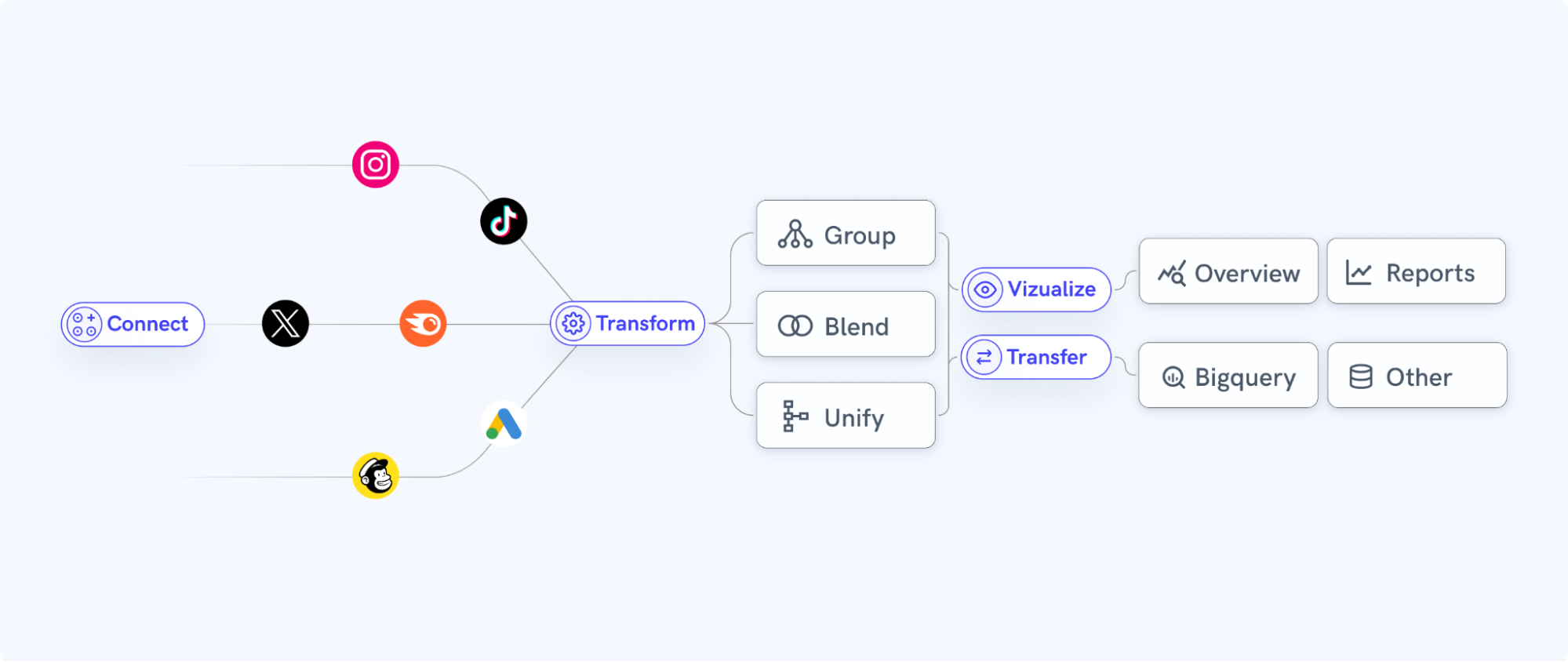
And whenever you have a question, you can reach out to our support team via live chat and we’ll respond to you within 1 minute.
All our pricing plans come with live chat and email support.
Plus, there’s a dedicated Customer Success Manager just for you.
But how does Whatagraph fit among the best AI tools for marketing analytics?
Let’s dig in.
#1. Reliable Integrations
The quality of your AI insights depends on the quality of your data.
Even the best-engineered AI workflows are worthless if the underlying data keeps breaking or showing wrong numbers.
Looking at how some competitors struggle with data connectors, we decided to make platform stability and data accuracy a foundation of Whatagraph.
How do we achieve that?
By building our data connectors ourselves!
Our integrations are fully managed, which means they’re more seamless, stable, and reliable than third-party connectors you can buy from different vendors.
For example, to connect your sources, you simply:
- Open Whatagraph, go to Data Sources and select the marketing platforms you need.
- Follow the on-screen instructions to provide the necessary credentials and connect each source.
- Once connected, Whatagraph will automatically pull in the latest data and update it automatically.
From there on, there’s nothing to update on re-connect on your part.
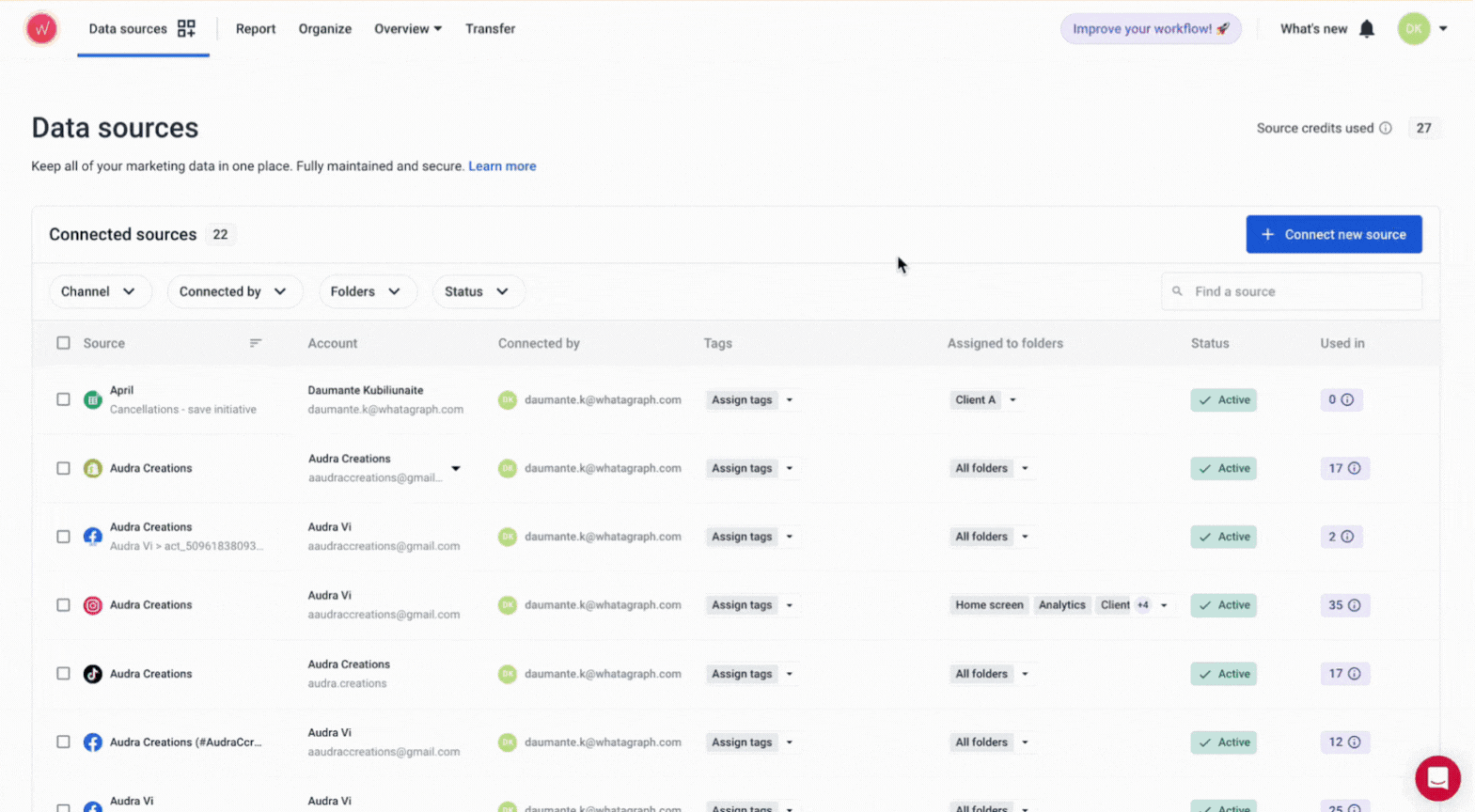
Our Product engineers regularly maintain them for fewer inconsistencies and network issues.
As far as the platform's speed is concerned, you can work with 10 sources and 100 widgets at the same time on Whatagraph without slowing down the platform.
Thanks to a recent update to Google Kubernetes Engine, even reports with heavy widgets, tabs, and charts take less than 10 seconds to load on Whatagraph.
And according to data from the past 6 months, Whatagraph has an average uptime of 99.95%.
We also have an emergency alert that will wake up all our Product engineers (even if it’s 3 am where they are) to quickly fix system outages, if there are any.
#2. Clean Data
Ok, you’ve connected all your data sources.
Now all your data is in one place, so you can easily analyze each channel’s performance.
You can grab a template and create a report or ask a question in the AI chat right away.
But what if you need to analyze reach and conversions across several PPC platforms?
What if your client wants to know the total engagement from all their social media accounts?
If you‘ve ever tried to combine data from several sources manually, you know all the struggles:
❌ Metrics and dimensions have different names on different platforms.
❌ You can have missing data for the same time period, which causes errors in spreadsheet calculations.
❌. Different platforms name locations differently (Great Britain vs. GB vs. United Kingdom vs. UK, etc.)
❌ Even campaign names can be hard to tell from one another.
All this can give you headaches whenever you try to get actionable insights from your data
Ok, but I have AI to tell me whatever I need to know.
Sure, you can try that, but even AI technology can’t tackle missing data, different metrics names between the platforms, anomalies in data, etc.
This is why you need to clean and consolidate data before exploring it with AI.
Whatagraph makes it easy to organize your scattered data and get actionable insights from it in minutes.
For example, you can:
- Blend data sources together: Great for combining different sources together into one unified data source for getting quicker insights and keeping your dashboard neat (no limits to how many sources you can blend).
- Create custom metrics: Unify and change the names of different metrics permanently in your report or create a new metric using a simple formula.
- Create custom dimensions: Unify names of different cross-channel dimensions and group data points from different sources.
All these features can help you prepare cross-channel data for AI analysis.
To conclude—AI data analysis is only as accurate as the underlying data.
Whatagraph helps you clean this data in a few minutes with zero coding.
#3. Actionable AI Insights and Summaries
A good AI-powered marketing analytics tool should be able to dive deep into your data and come back with meaningful insights.
Whatagraph’s AI chatbot checks that box with flying colors.
And yet, Whatagraph’s incredibly simple and easy to use.
Anyone from your team—whether an Account Manager or an intern—can easily log into Whatagraph and start using it immediately.
The best thing is that you can jump straight into AI insights without even creating a report.
Our AI Chatbot can answer any question about any of your connected data sources.
This includes blended sources and source groups.
Simply click on the blue chatbot icon in the bottom right corner and type a question or use one of the suggested prompts.
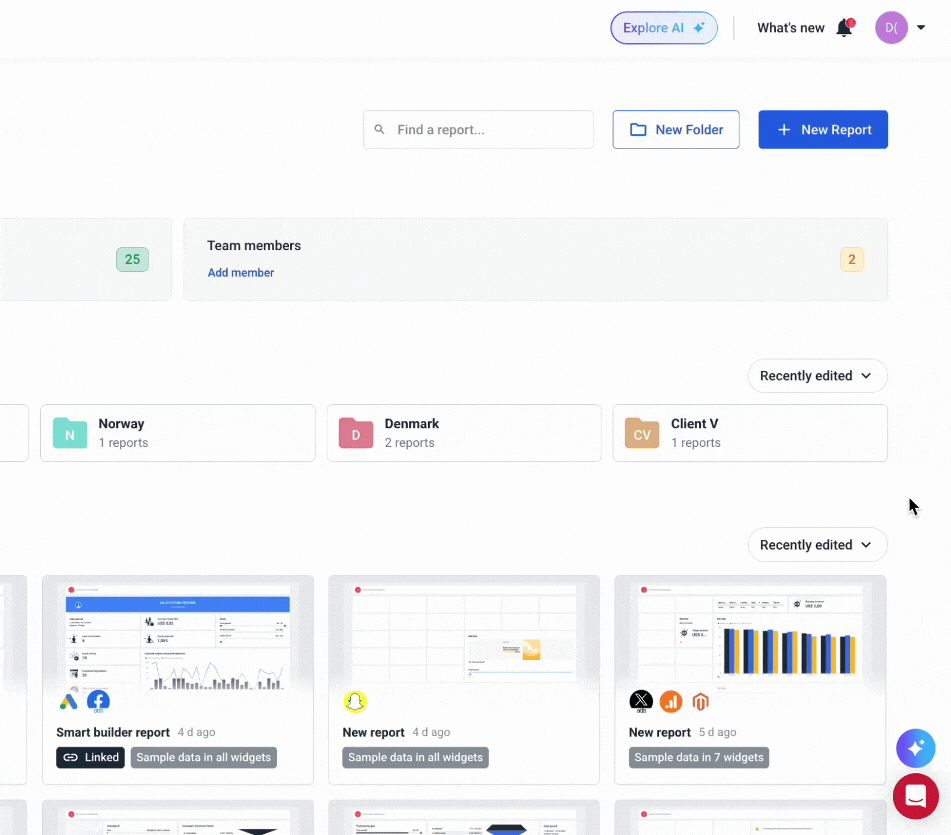
In both cases, you can select the source or sources and date range that you want the AI agent to analyze.
Then, you can copy the answer and paste it directly into any conversation you might be having with your client.
You can ask very specific things about your marketing campaigns and get a very detailed answer with its own Key Insights:
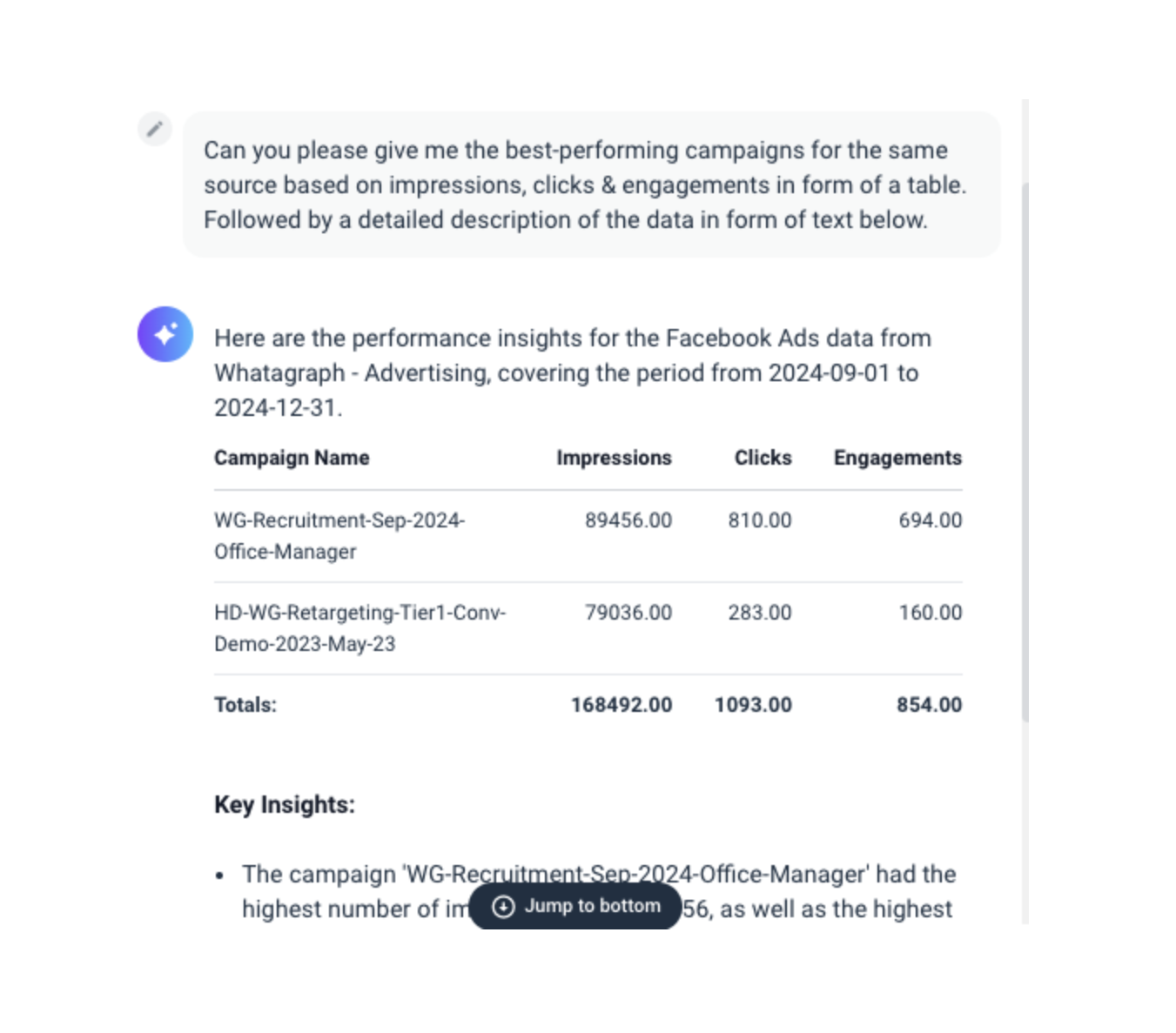
Great for saving time answering those ad-hoc questions from your clients.
Our AI chatbot can also read the history, so if you don't like a part of the answer, you can ask it to make any adjustments.
Another quick way you can get valuable insights from your data is through AI Report Summaries.
Writing comments and insights manually takes some time.
Between deciding what to say and what angle to take… you end up with a few bullet points that took you 10 minutes to write.
With Whatagraph AI, creating a summary takes no longer than 10-15 seconds:
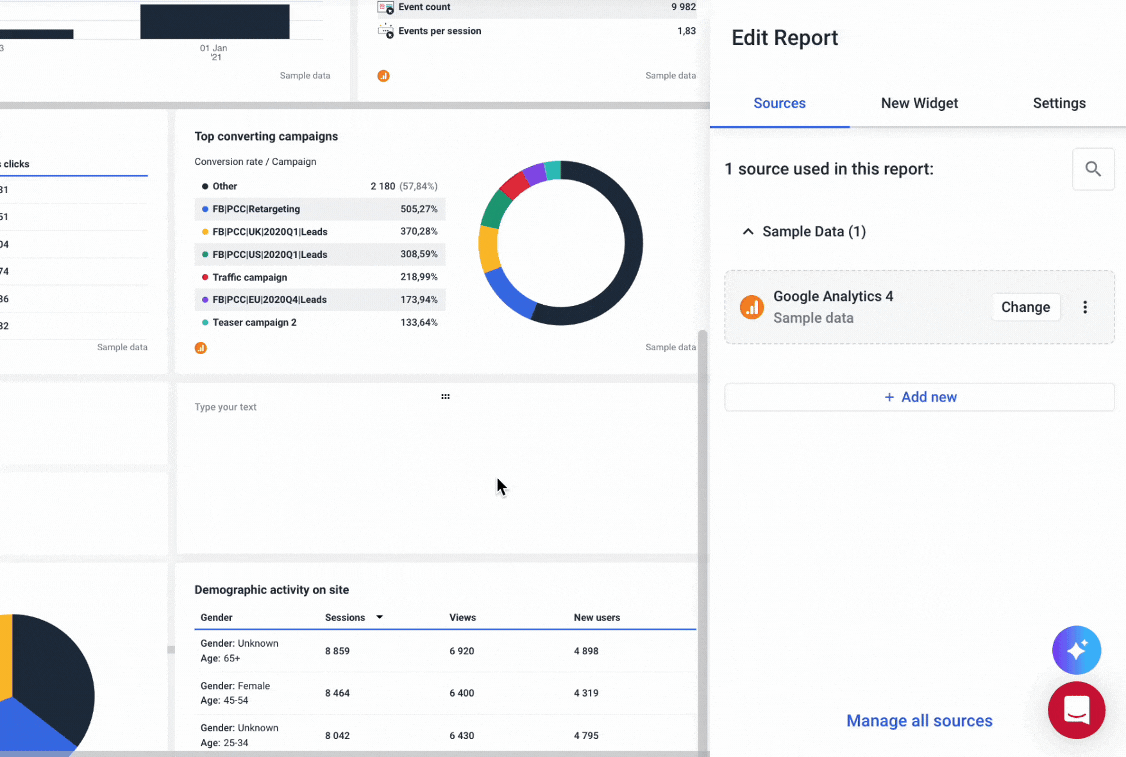
Then, you can edit the summary, include your own thoughts, and add it to a Text Widget.
#4. Performance Monitoring
Let’s say you have 100s of scattered data points across different sources, campaigns, channels, and accounts.
Even if you connect all those sources with one tool, the problem is that actionable insights, trends, and patterns are hidden under a heap of data.
Thanks to recently launched Performance Monitoring, Whatagraph can help you get actionable insights from your data without breaking a sweat:
- Source groups: Group 100s of scattered data sources into a unified source group in seconds.
- Custom tags: Add custom tags to your data and filter it by client, business type, location, Account Manager, etc.
- Overviews: Create an internal dashboard of your clients’ accounts in one view and easily spot performance trends.
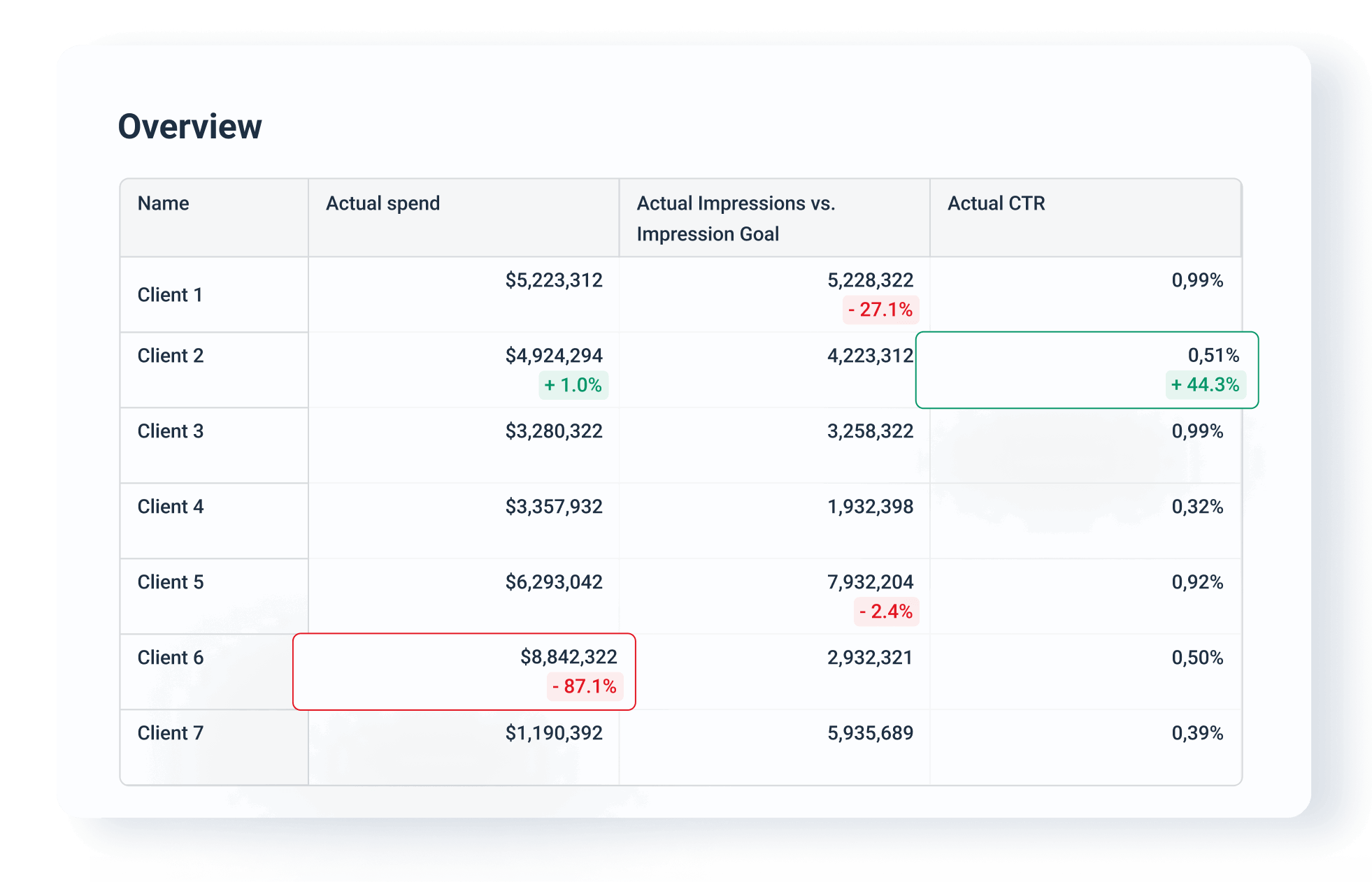
The Overview is especially useful for bigger marketing agencies, who can use it for
- Unified view of their client portfolio
- Team performance tracking
- Faster, data-driven decision-making
#5. Security
User data security is one of the pillars of Whatagraph.
We are ISO 27001 certified and GDPR compliant.
You have full control over the data Whatagraph has access to and the transactions that occur, and you can request us to delete all your personal data any time.
We've also built our systems from the ground up in line with best practices in security and data protection:
- Access to information resources is granted according to an individual’s role and the data classification. Each employee uses a unique password with a minimum of 8-10 symbols to log into their account, which is secured with 2-step verification. To ensure the highest level of data protection, passwords must be changed to a new one every 6 months.
- We encrypt data using AES-256 encryption.
- We obtain your data through third-party data integrations and create backup copies. These copies are retained for a specified period or until they are no longer relevant, after which they are deleted.
- We offer Enterprise-SSO on all pricing plans.
Plus, all of our services run in the cloud. We do not host or run our own routers, load balancers, DNS servers, or physical servers.
Instead, we use Google Cloud Platform and Amazon Web Services to process your data.
These organizations have excellent compliance and regulatory audits, including SOC 1/2-3, PCI-DSS, and ISO27001.
As a result of these security measures:
✅ Your business data is safe from cyber threats both in transit and at rest.
✅ Your reputation is protected from the negative consequences of data breaches.
✅ The chances of downtime and financial loss as a result of data breaches is minimal.
Key features
- 55+ native integrations
- Custom integrations through Custom API, Google Sheets, or BigQuery
- Versatile drag-and-drop widgets for reports and dashboards
- Custom metrics, dimensions, and data blends
- AI insights
- Currency conversions
- Library of pre-made dashboard and report templates
- Export to Excel and CSV
- Custom branding and white-label features
- Automated report sharing via email
- Links to live dashboards
- No-code data transfer to BigQuery and Looker Studio
Whatagraph reviews from real users
“To me, Whatagraph is like the Tesla or Mercedes of digital analytics tools, their clean and simple way to present complex marketing data. I highly recommend it to anyone working with marketing analytics who values efficiency and clarity in their reporting.” (Source)
“Whatagraph has a simple user interface that is easy to navigate even for those who don't have analytical skills.” (Source)
“What I like best about Whatagraph is having the ability to create reports fast and easy. No more spreadsheets to do reports, they have a great variety of templates.” (Source)
Pros:
- All-in-one marketing performance monitoring and reporting solution
- Easy to use by anyone on your team
- Fast campaign performance and insights
- Stunning visual reports
- Makes results easy to interpret
- Excellent live chat customer support
Cons:
- No freemium plan
- Can be expensive for small agencies (under 10 employees) and freelancers
Pricing
Whatagraph offers three pricing plans based on the amount of “source credits” and access to customization and data organization capabilities.
You can use source credits to connect data sources, send data from a source to a warehouse, and blend cross-channel data together.
Reach out to us for a custom pricing plan, just for you.
2. AgencyAnalytics
Most suitable for: PPC and SEO marketing agencies
AgencyAnalytics is a user-friendly reporting software, designed for small to mid-sized marketing agencies that need streamlined monitoring and reporting for their ad campaigns.
You can connect to 80+ data sources, including Google Analytics 4, Google Ads, Facebook, Instagram, Shopify, and LinkedIn.
AgencyAnalytics offers the Ask AI feature, which you can use to quickly examine the dashboard or report results in depth.
Ask AI can analyze entire dashboard sections, pre-built integration dashboards, or individual widgets on dashboards and reports.
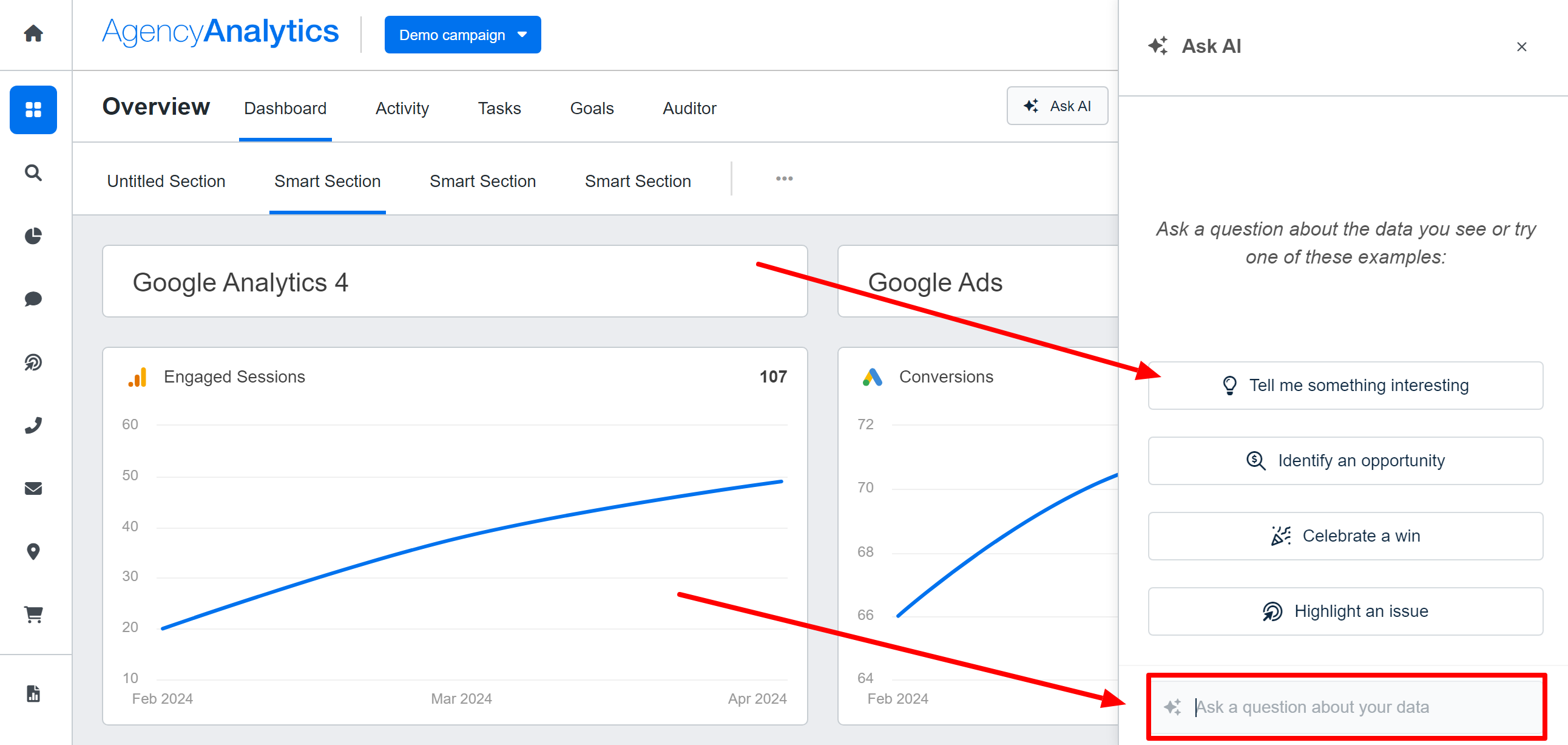
You can ask your own questions about the data on your dashboard or select one of the pre-made prompts.
For example, if you select the “Identify an opportunity” prompt, it can uncover an area which could be improved to increase engagement.
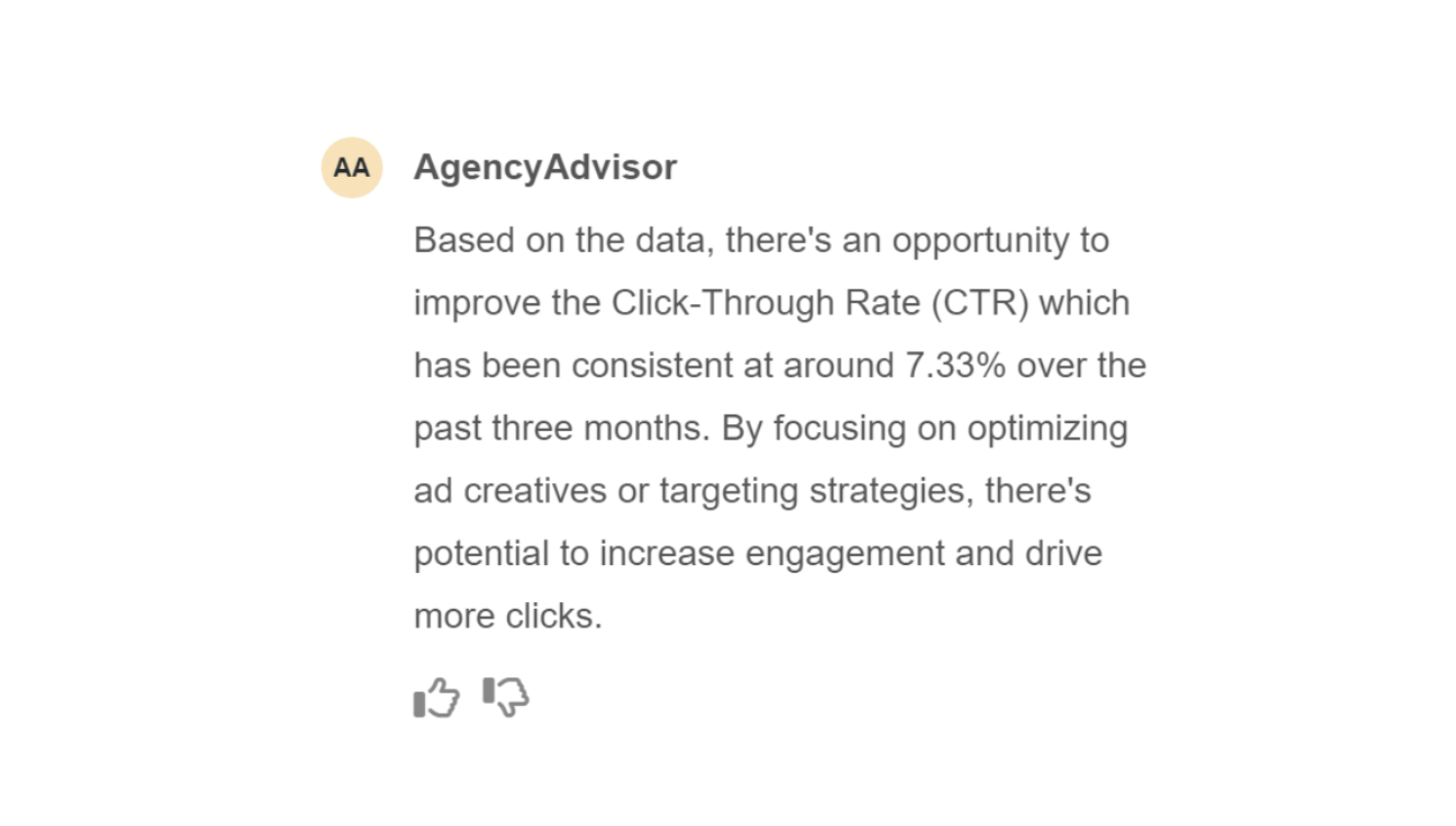
Another AI-powered AgencyAnalytics feature is AI Widget Summaries.
You can generate them for chart and graph widgets or add them to reports as standalone widgets.
Note: Any changes you make after generating the summary won’t show unless you delete and re-add a fresh AI summary.

To lock in the changes you made, make sure you click “save the Report” in the upper right-hand corner of the editor.
On the reporting side, AgencyAnalytics is easy to use, as you don’t need technical expertise to create decent-looking reports.
However, if you want to customize them any further than the basics, there’s a steep learning curve.
We’ve also heard multiple times that users wish for more flexibility in redesigning their visuals on AgencyAnalytics.
Another complaint is that the platform can be unstable, as sources can disconnect frequently due to “service bandwidth” issues.
This is especially evident with social media or proprietary software connections.
AgencyAnalytics also lacks advanced data calculations, and its dashboards are limited and not very flexible.
Key features:
- Direct integrations
- Ready-made templates
- White-label reports and branding
- User roles and collaboration
- AI features
AgencyAnalytics reviews from real users
“I like that it is set up with drag and drop functionality with a variety of formats to easily display data. The ability to clone templates to use for other accounts greatly speeds up new client implementation as well.” (Source)
“It can sometimes be a little buggy and take time to load. Adding new integrations can sometimes be challenging because of this.” (Source)
“There are limitations on how you design the reports. It's also not clear if you have a scheduled report going out that requires approval before it goes out.” (Source)
Pros:
- Easy to use with minimal technical expertise
- Large library of templates
- Cost-effective
Cons:
- Glitchy
- No advanced data calculations and organization features
- Limited integrations
Pricing
As of February 2025, AgencyAnalytics offers three plans:
- Launch: $79 or $59/month, paid yearly for 5 client campaigns and basic branding.
- Grow: $239 or $179/month, paid yearly for 10 client campaigns, AI features, metric alerts, and full branding.
- Perform: $479 or $349/month, paid yearly for 15 client campaigns, trend forecasting, and data aggregation.
3. Klipfolio
Most suitable for: Large data teams at companies and large agencies
Klipfolio is a data analytics and business intelligence platform in one. It offers two key products:
- PowerMetrics: Designed for data teams at large companies, this is a data analytics tool to centralize, standardize, and share accurate metrics throughout the organization. Non-data teams can then use these certified metrics for their dashboards and reporting needs.
- Klips: These are your regular data visualization dashboards and reports. Klips integrates 130+ platforms, and you can also use the Rest/URL option for custom integrations.
With PowerMetrics, you can connect all your data sources and more:
- Create a curated metric catalogue for other business teams with access control and governance features.
- Run self-serve analysis and AI insights.
- Store data in one place—in your data warehouse, semantic layer, or in PowerMetrics itself.
- Share transformed and unified metrics with anyone in the organization.
These features help you speed up decision-making and reduce ad hoc requests to data teams.
That is if you have a dedicated data team in the first place.
You can use PowerMetrics’ AI functionality to converse with your marketing data using natural language.
The natural language processing algorithm can interpret your questions and automatically create the visualizations you need.
When you discover something you want to share, you can save the visualization to a dashboard for easy access.
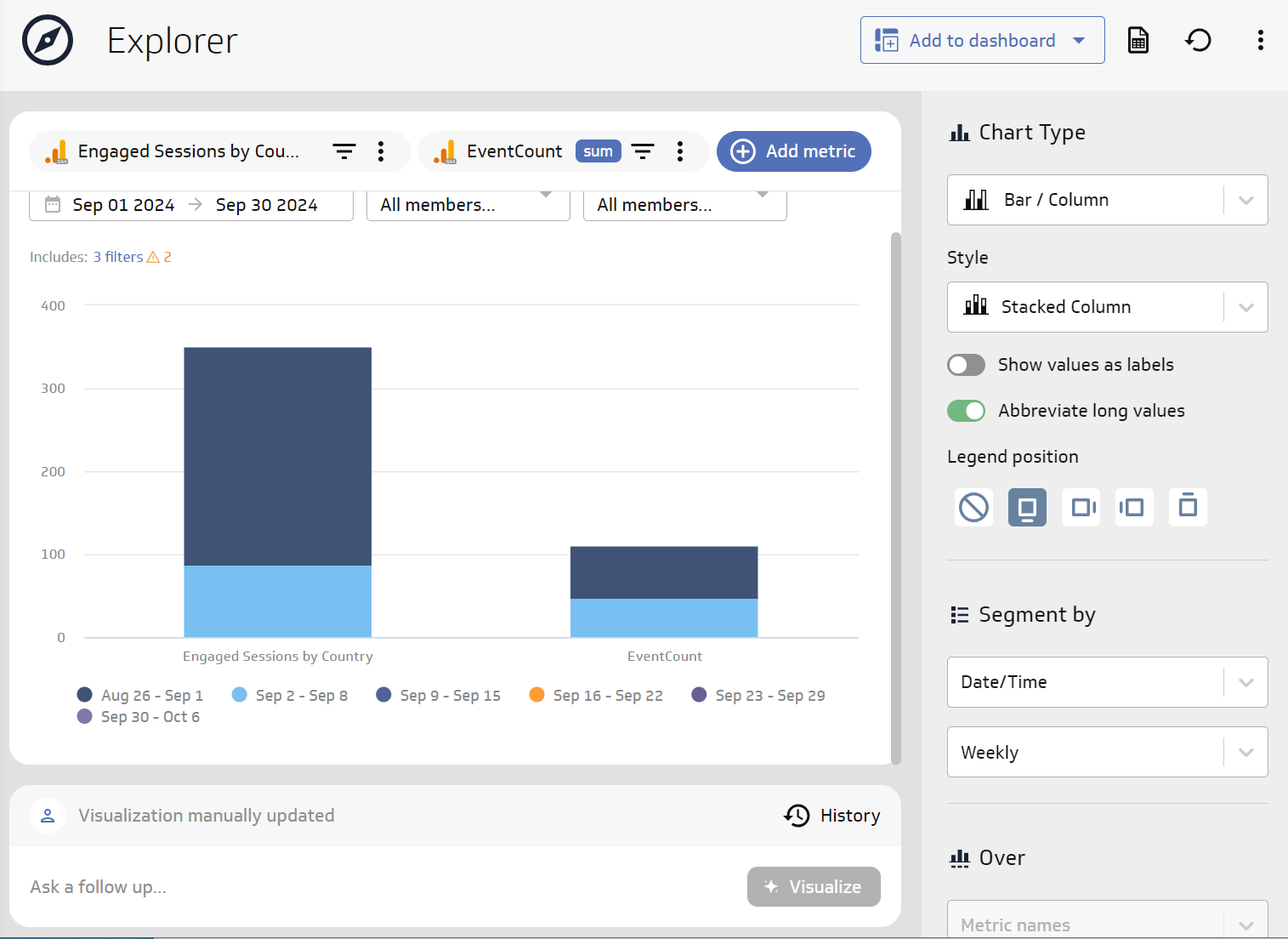
Getting started with Klipfolio is easy. Once you create a Trial account, you get access to your first dashboard.
But this is where things get complicated. To visualize your data, you’ll first need to create a “Klip”, which is in a different tab from the dashboard.
There are some pre-made Klips but for the most part, you’ll need to build a custom one.
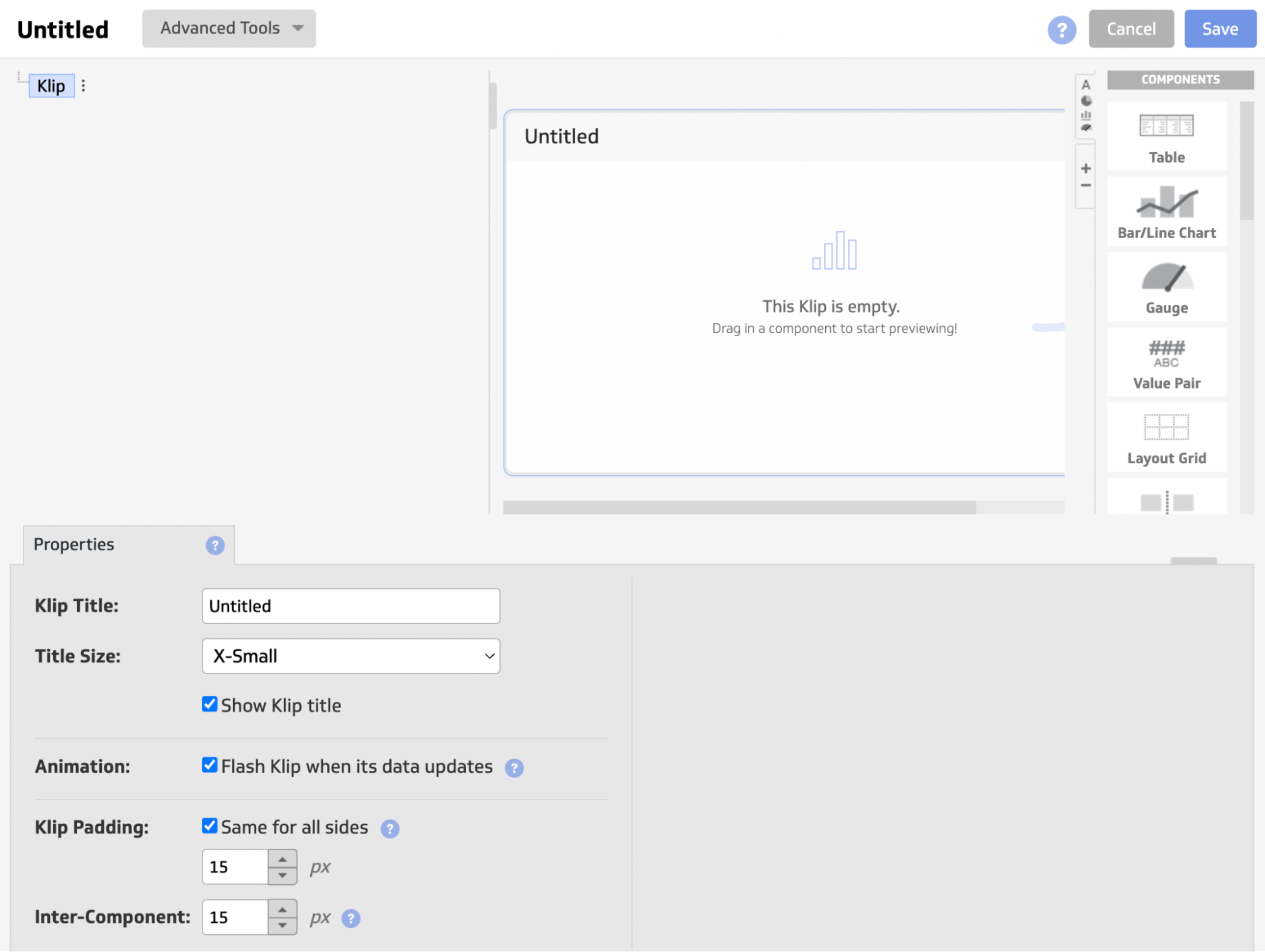
The interface to create a custom Klip can be confusing and clunky (although there is an interactive tour).
It can take you anywhere from 5 to 30 minutes to build a Klip, depending on how complex you want it to be.
Key features
- 130+ integrations, including warehouses, SQL databases, and file-sharing services
- Data blending, unifying, aggregating
- Custom metrics and dimensions
- AI insights
- Custom dashboards and reports
- Export dashboards as PDF or image files. Export only individual clips as CSV
- Scheduled reports
Klipfolio reviews from real users
“I needed something to convert Google sheets into dashboards to monitor our maintenance logs. Klipfolio is an incredibly intuitive quick solution.” (Source)
“The platform can run a little slow sometimes, particularly when performing complex actions. With Klips, data sources are always fully refreshed when loading up a dashboard, which can drag down the performance when working with multiple data sources at the same time.” (Source)
“I really dislike their training style. It's costly, and you have to pay a lot for a support ninja to help you. If you're a small company, it can run up your bill fast.” (Source)
Pros:
- Easy to use and set up
- Powerful data analytics and organization options
- AI insights to help make data-driven decisions
Cons:
- Expensive with important features only available as add-ons or in Enterprise plans
- Limited customization for dashboards and templates
- Unhelpful customer support
Pricing
Klipfolio offers three pricing plans for two of their products: PowerMetrics and Klips.
As of February 2025, here are the plans for PowerMetrics:
- 30-day free trial
- Professional: $300/month for 10 users and unlimited metrics.
- Enterprise: Custom pricing for 10 users, unlimited metrics, and priority support.
The Enterprise plan comes with data warehouse integration, AI insights, and custom domains, which are only available as add-ons on the Professional plan.
Klips’ pricing is further divided into plans for businesses and for agencies.
As of February 2025, here are the plans for businesses:
- Base — $90/month for 3 dashboards and 4 hr data refresh rate. No priority support or custom onboarding available.
- Grow — $190/month for 10 dashboards and 1 hr data refresh rate. No priority support or custom onboarding available.
- Team — $350/month for 20 dashboards and 15 min data refresh rate. No priority support or custom onboarding available.
- Team+ — $690/month for 60 dashboards and up to the minute data refresh rate. Includes priority support and custom onboarding.
Here are the plans for agencies:
- Agency Starter — $110/month for 5 dashboards, 5 clients, and 4 hr data refresh rate. No priority support or custom onboarding available.
- Agency Lite — $190/month for 15 dashboards, 15 clients, and 1 hr data refresh rate. No priority support or custom onboarding available.
- Agency Pro — $420/month for 30 dashboards, 30 clients, and 30-min data refresh rate. No custom onboarding available.
- Agency Premier — $1025/month for 80 dashboards, 80 clients, and 30-min data refresh rate.
4. Databox
Most suitable for: Boutique agencies and small businesses
Databox is a data reporting and analytics platform for growing businesses.
You can integrate with 100+ marketing tools and connect custom data through Google Sheets or Excel. Then, you can visualize this data directly on Databox using pre-built metrics and templates.
Once you log in to Databox, you’ll see an overview of your key metrics and performance summaries created by generative AI.
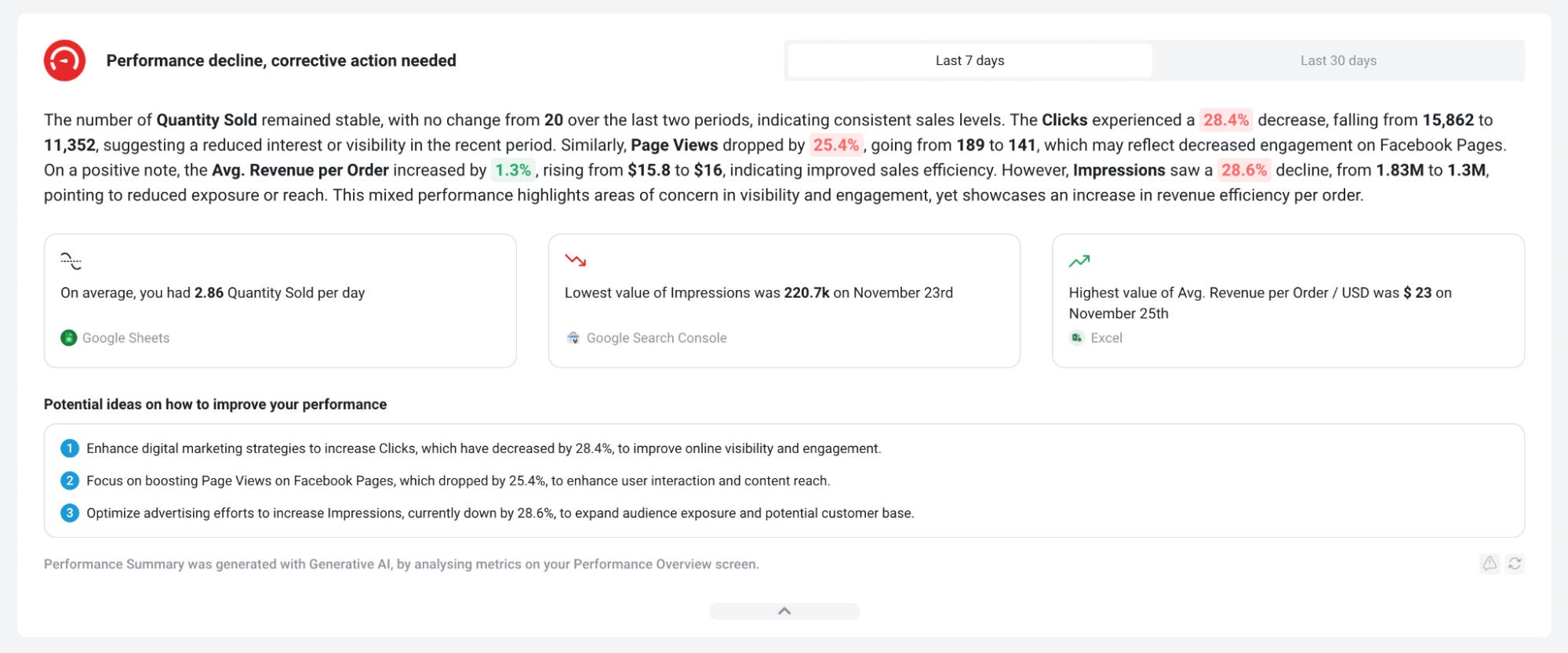
You can use generative AI performance summaries to get personalized recommendations for your metrics, goals, and Databoards.
For example, to get the AI summary for a specific Datablock, hover over the Databoard and click “Edit”.
This will open the Databoard in the Designer. Click on the “Performance Indicator” icon in the top right corner of the Datablock.
This will open the performance summary for that specific Datablock.
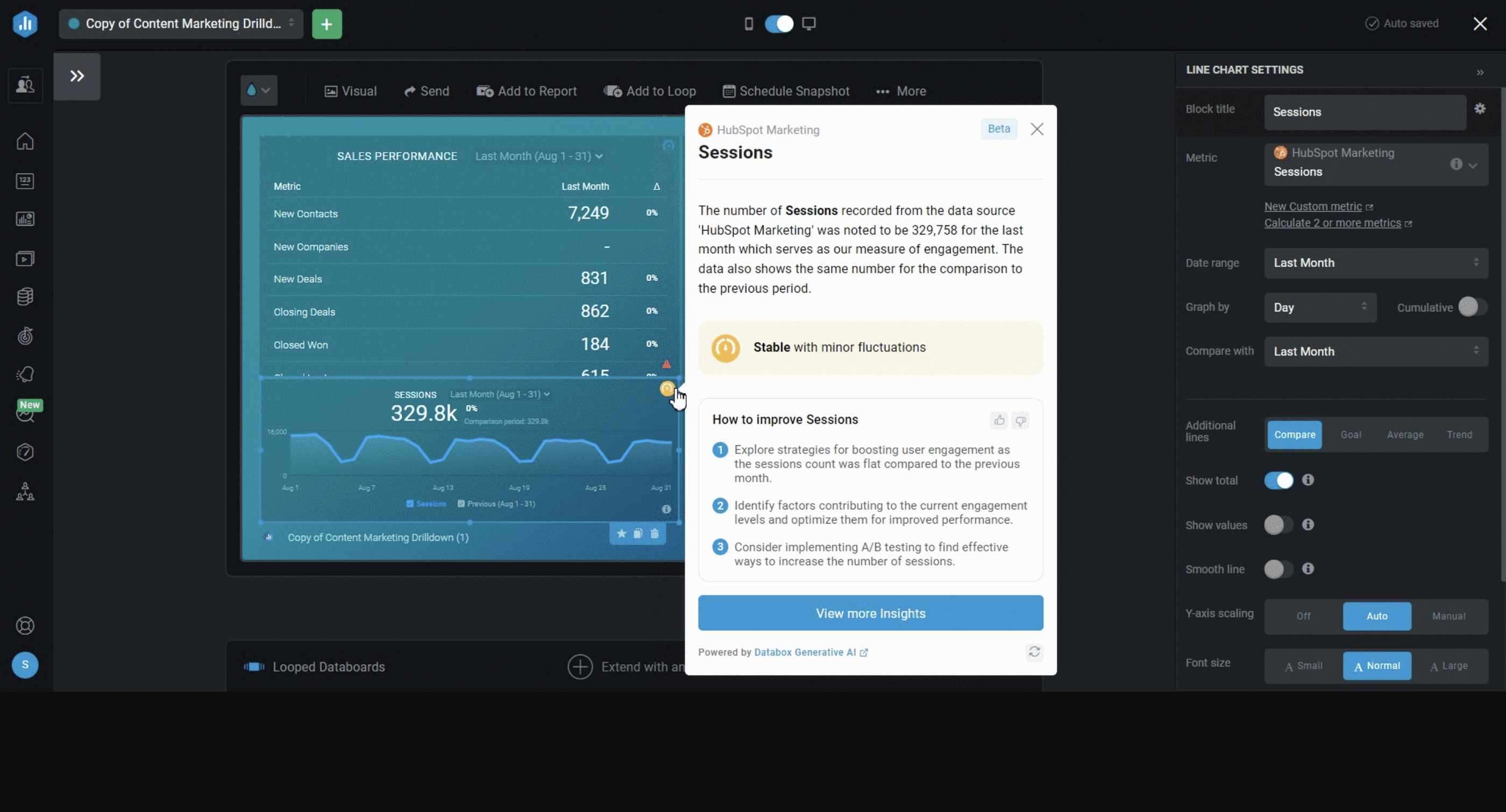
These AI-generated widget summaries help you understand performance at a glance.
However, things get complicated when you actually start to build your own dashboard.
You’ll need to manually configure three separate components:
- Metrics: individual metric widgets
- Databoards: live data dashboards (mostly for internal teams)
- Reports: PowerPoint slides style reports (mostly for clients or C-Suite)
For example, within a Databoard, you’ll need to manually customize each widget, e.g. a line chart.
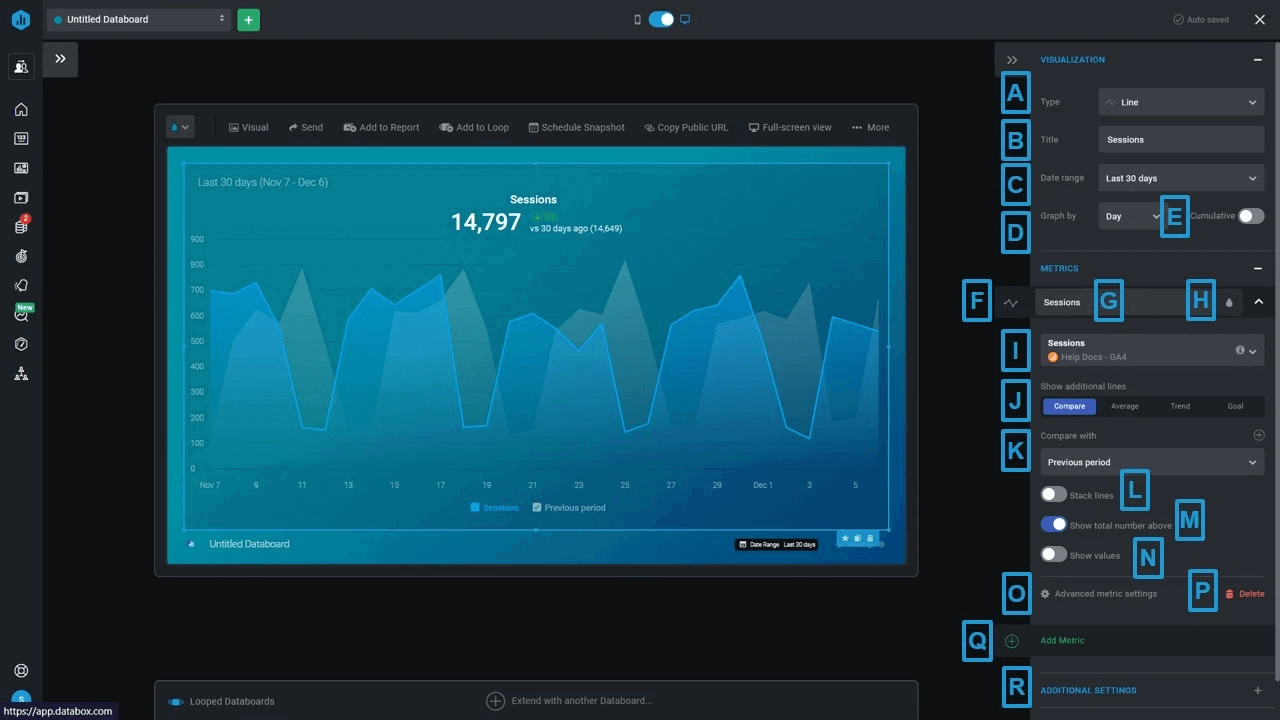
And if you want reports, you’ll need to create a separate “Slide presentation” and manually configure the design all over again.
Databox’s reports are also not linked, which means you’ll need to edit them one by one rather than in batch.
All of these can add hours to reporting.
Databox users online also say their integrations break often and there are frequent data outages.
In addition, there’ve been multiple reports of Databox running very slow.
Key features
- 100+ integrations
- Native visualization dashboards and reports
- Dashboard and report templates
- Slack, email, or in-app alerts
- KPI benchmark groups
Databox reviews from real users
“I like best that Databox provides all of your sales metrics in one place combined with multiple data sources. So you can have all your business to business sales combined.” (Source)
“The data visualization options could use more customization options, particularly with text editing. It's great for basic live dashboards, but we struggle to use this for complete reports because it doesn't give us much of an option for complete analysis.” (Source)
“One issue with them took two months to fix. Meanwhile this was a huge issue that prevented me from even testing the platform with clients. The issue did not allow me to choose individual Facebook or Instagram accounts.” (Source)
Pros:
- Easy to use
- Wide variety of integrations
- Interactive data
Cons:
- Slow customer support
- Bugs and lag issues
- Broken metrics and templates
Pricing
Databox offers five different pricing plans as of February 2025:
- Free Forever: Limited to 3 users, 3 dashboards, and daily data updates. No custom metrics, data calculations, or report automation available.
- Starter: $388/month for 50 data sources, 5 users, and unlimited dashboards.
- Professional: $528/month for 50 data sources, unlimited users, unlimited dashboards, and hourly updates. Includes custom metrics and data calculations.
- Growth: $728/month for 50 data sources and unlimited users, dashboards, and historical data.
- Premium: $999/month for 100 data sources, and unlimited dashboards and historical data.
Databox also offers paid add-ons like White-labeling ($250/month) and Guided Onboarding $500/month.
5. NinjaCat
Most suitable for: Marketing agencies and brands with dedicated data scientists
NinjaCat is an end-to-end platform for connecting to your data sources, cleaning the data, visualizing it, and shipping it to destinations.
You can integrate with 100+ pre-built connectors, including CRM, search engine advertising, web analytics, e-commerce, email marketing, and project management tools.
You can then simplify and harmonize your data with no-code transformations and custom calculations.
There’s also an option to store your data in a managed warehouse.
Alternatively, you can ship your data to external storage destinations like Snowflake, BigQuery, or Amazon S3 or business intelligence destinations like Tableau and Looker Studio.
As far as artificial intelligence options are concerned, NinjaCat has two features:
AI Agents: Designed to automate specific tasks, these AI assistants help you save time and optimize performance while digging out deeper insights from your data.
For example, the Campaign Performance Monitoring Agent monitors ad spend in real-time, alerting you to overspending and inefficiencies to protect your budget.
The Content Creation Agent assists in copywriting by analyzing ad copy and suggests improvements to boost engagement and conversion rates.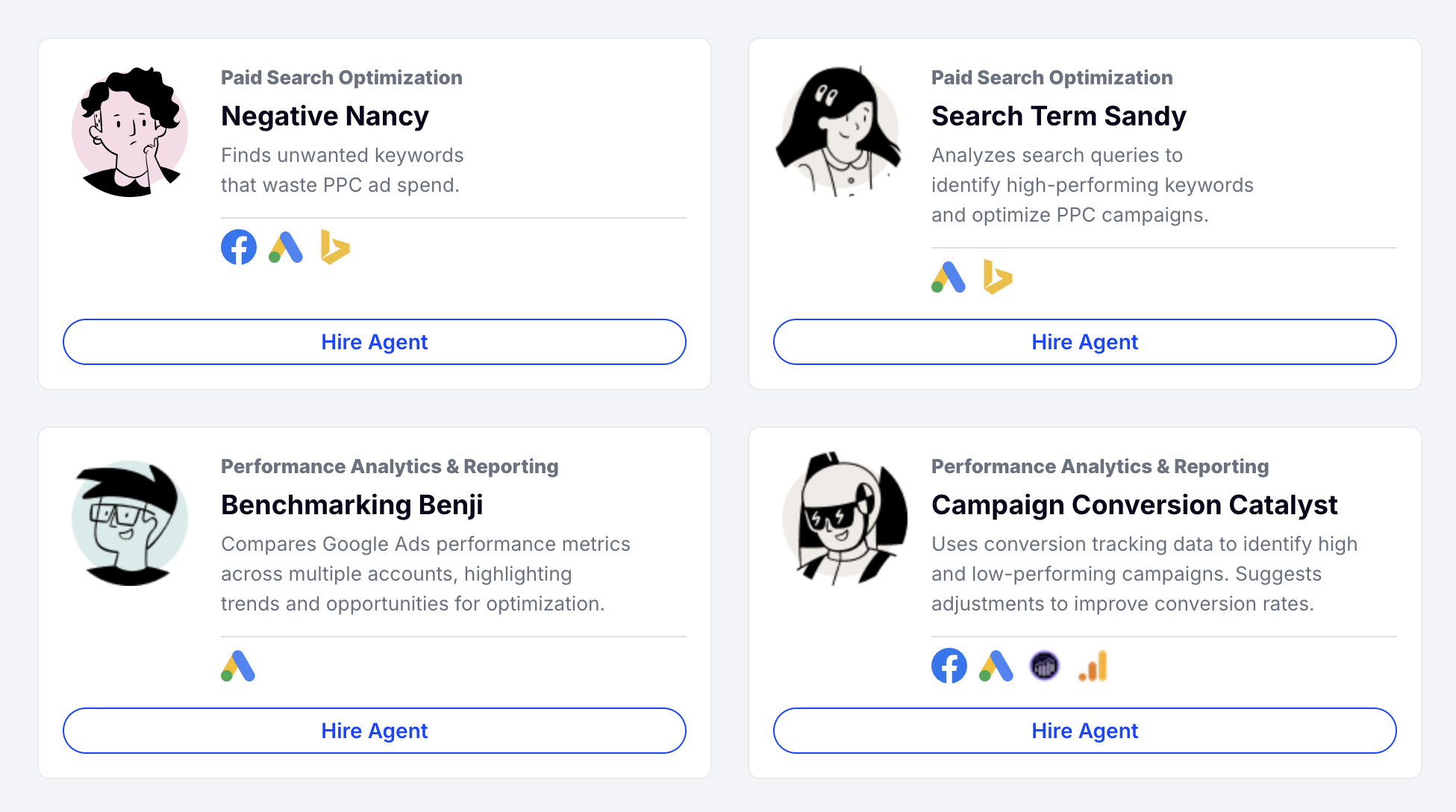
AI Insights Generator Widget: This is an AI summary widget you can link with a data widget in the template builder. It generates automated text about the connected data, depending on the prompt and language settings.
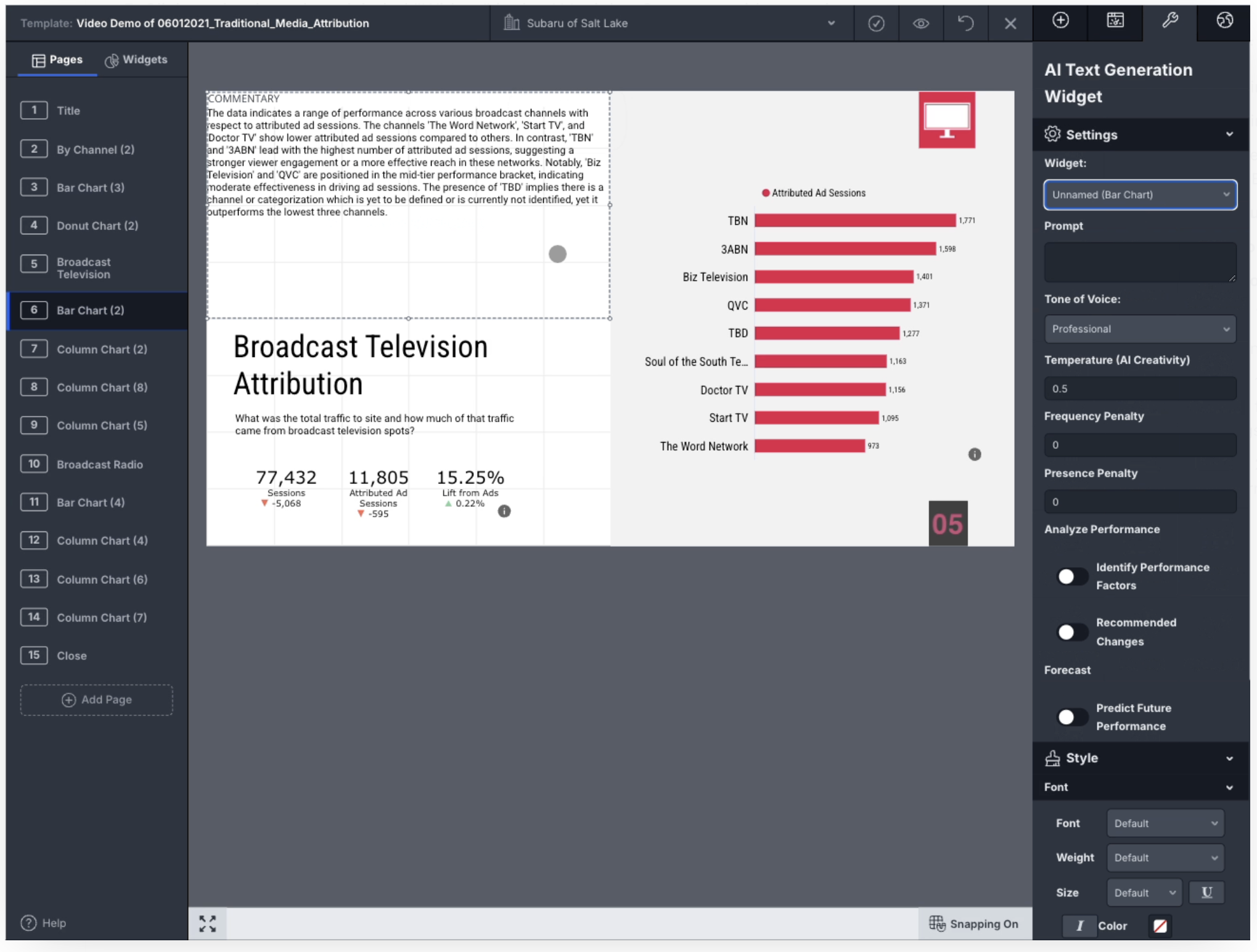
When it comes to creating reports, you can start from a blank template (that looks like a “canvas”) and add and adjust metric widgets as needed.
Key features
- 100+ pre-built connectors
- No-code transformations and calculations
- Data transfer to BI tools and data warehouses
- Easy ad spend and campaign performance monitoring
- White-label options
- White-glove setup and service
NinjaCat reviews from real users
“NinjaCat helped us have a single pane of glass for all of our advertising channels in one place. Additionally, it has reduced the amount of time our team has had to put into our reporting decks.” (Source)
“NinjaCat can be finicky at times, so I struggle to use it as a live dashboard. I think it works stronger for me when I'm using a standard report during a set time frame that I can download.” (Source)
“When processing a large number of groups it can take a while. Users often run reports at the same time each month, however we are a large client with over a thousand reports that need run.” (Source)
Pros:
- Automated client reporting
- One platform for integration and visualization
- Multiple choice of destinations
- Custom branded reports
Cons:
- Separate workspaces to organize and visualize data
- Complex visualization builder
- Performance issues with reports
- No autosave in case of a crash
Pricing
NinjaCat doesn’t offer fixed pricing plans, and no information is available on its website.
6. TapClicks
Most suitable for: Medium to large companies with PPC and SEO campaigns
TapClicks is not your regular digital marketing platform—it’s eight different products bundled into one. Here’s a quick breakdown of what each component does:
- TapData – Move your data between platforms, create custom data blends, and format it however you need.
- TapReports – Build custom dashboards and automate reporting for clients.
- TapAnalytics – Spot market trends and opportunities from your data to improve decision-making.
- TapInsights – Get AI-powered recommendations to optimize campaigns.
- TapOrders – Automate client orders, CRM imports, and online forms—ideal for eCommerce businesses.
- TapWorkflow – Streamline task management and workflows to boost efficiency.
- Raven by TapClicks – Run SEO audits, keyword research, and rank tracking.
- Competitive Intelligence – Gather local SEM data insights to create better client proposals.
This might sound impressive, but according to user reviews, TapClicks tries to do everything but struggles to excel at any one thing.
We’ve heard complaints like frequent connection failures, inaccurate reporting, and a steep learning curve—even with months of onboarding support.
As an AI marketing analytics tool, TapClicks uses ChatGPT to help you analyze datasets and create in-depth summaries of your dashboards.
You can use ChatGPT in two ways on TapClicks:
- Add a ChatGPT widget to dashboards: This widget displays the ChatGPT interface and responds to your prompts in the same way as the ChatGPT website does.
- Send widget data to ChatGPT: In this case, ChatGPT will automatically generate a detailed summary that you can add to your executive summary.
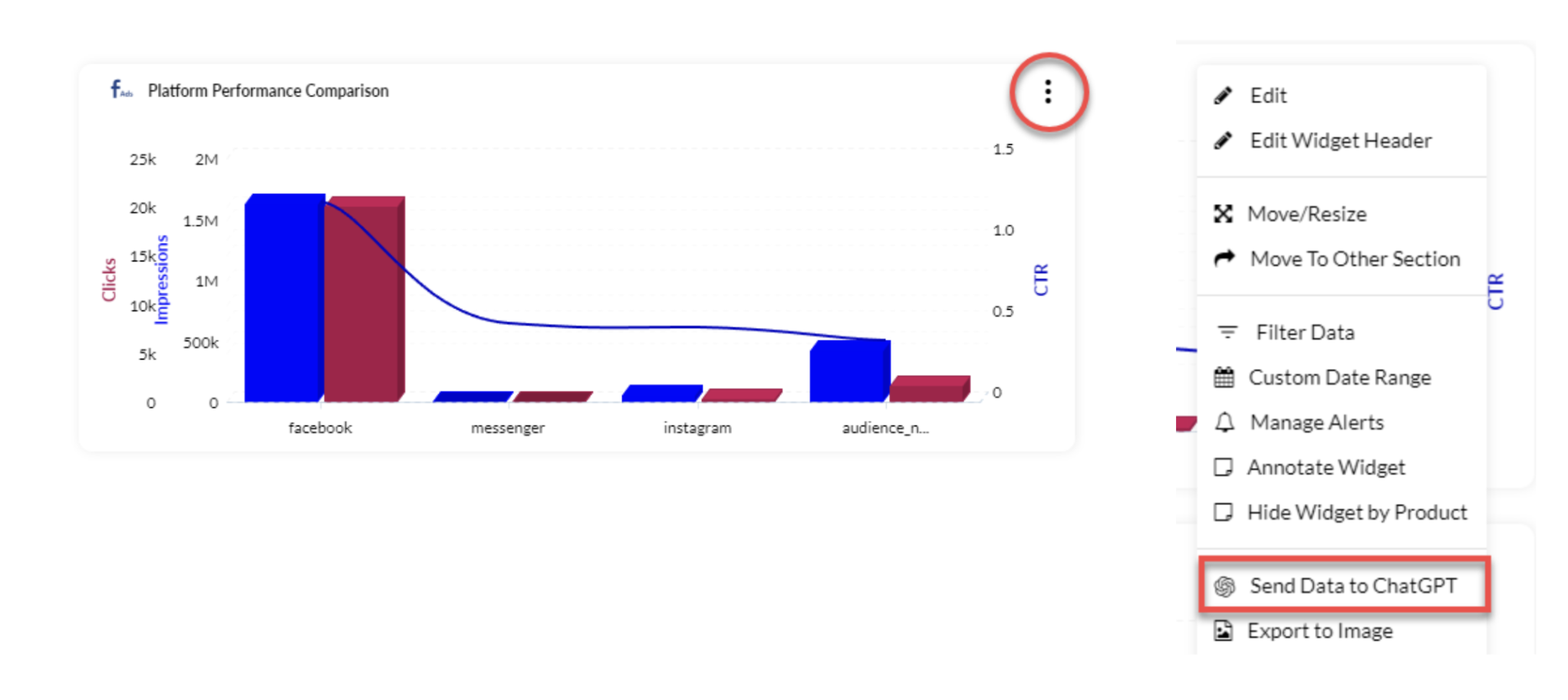
Key features
- Wide variety of integrations (their website doesn’t say exactly how many)
- Advanced data calculations
- Data Exporter to send data to data warehouses, databases, and data visualization tools
- Interactive dashboards
- AI-powered insights
- Report automation
TapClicks reviews from real users
“The ability to pull data from all places via the built-in connectors. If there is not a native connector, you can also pull the data through the platform's smart connector.” (Source)
“While TapClicks offers robust analytics, sometimes the interface can feel overwhelming, especially for new users.” (Source)
“One area where TapClicks could improve is in addressing data discrepancies, especially in real-time dashboard updates. In my experience, I've encountered instances of data mismatches that hindered the accuracy of the reports.” (Source)
Pros:
- Powerful data analytics
- Customizable and interactive dashboards
- Responsive customer support
Cons:
- Steep learning curve
- Data inaccuracies
- Connection issues and lags
Pricing
TapClicks’ pricing can be confusing as you’ll need to build your own packages.
You start by choosing your data package:
- TapDataLite: $99/month for 64 connectors
- TapData+: $349/month for 250+ connectors
- TapData Max: $649/month for 250+ connectors and API access
Then, you choose your data destination:
- TapReports: $199/month for report automation, custom branding, and advanced calculations
- TapAnalytics: $899/month for custom channels, margin & markup rules, and interactive dashboards
- TapInsights: $1399/month for AI-generated executive summaries, configurable alerts, and benchmark widgets
- Third-party destinations: Custom pricing
All destination packages come with 10 clients and unlimited users.
Looking at these pricing plans, even the lightest data package with the reporting package which includes AI capability costs you almost 1,500 dollars a month.

WRITTEN BY
Nikola GemesNikola is a content marketer at Whatagraph with extensive writing experience in SaaS and tech niches. With a background in content management apps and composable architectures, it's his job to educate readers about the latest developments in the world of marketing data, data warehousing, headless architectures, and federated content platforms.